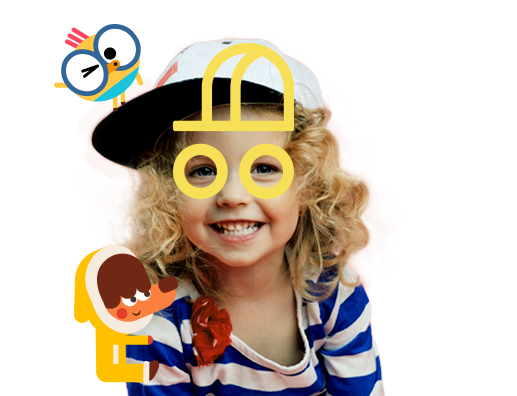The first step for children learning English is to acquire vocabulary. Having a rich vocabulary, and learning about verbs, allows them to identify more objects and to be fluent while speaking. For native English speakers, this comes easily, since they are exposed to the language from an early age. However, for children studying English as a second language, learning verbs might be a bit more complicated. This is why is recommended to start with the basic ones, like the verb “to have”.
The “to have” verb is the second most commonly used verb in the English language, after the verb “to be”. In English, the “to have” verb has many different uses. It can be the main verb, or it can be an auxiliary verb, and it can change meanings depending on the context where it’s used.
Now, let’s take a look at the different uses, meanings, and forms that the verb “to have” has, to help your little one learn it in a natural, fun way.
What are the uses of the verb “to have”?
In English, there are two main uses of the verb “to have”, first as the main verb, this is when it has a meaning by itself and it’s the acting verb of the sentence, and second as an auxiliary verb. When used as an auxiliary, the “to have” verb doesn’t have a specific meaning in English, but it’s still very important, since it helps form more complex tenses. Also, there’s a third use for this verb, and it’s when “to have” is a modal verb, in which case it’s used to express necessity or obligation.
When used as a main verb, the meaning of the verb “to have” indicates possession and ownership, like in the sentence “I have a bike”, and also it can mean to perform an action, for example, “Lisa has breakfast every morning”, where the “to have” verb is used to talk about the action of eating breakfast.
Also, the verb “to have” can be used to make questions in English, both for Wh- questions and for yes or no questions.
Forms of the verb “to have”
The “to have” verb is an irregular verb, which means that it changes its spelling depending on the three main forms it takes: present, past, and past participle. Let’s see the different forms of “to have” with the different subjects, and for affirmative and negative sentences.
Base form: have
The base form is the main one, and it’s the one used to find the verb “to have” in the dictionary. Its main use is to make imperative sentences, and also to make the infinitive by adding “to” in front of it.
Have a piece of cake! (imperative)
She plans to have a party next week. (infinitive)
Present
The present form of “to have” is mainly used to form the simple present of a sentence. Since this verb is irregular, there are two ways of writing it in the present: “have” or “has”, and deciding to use one or the other depends on the subject of the sentence.

Affirmative of the verb “to have”:
I have
you have
he/she/it has
we/they/you have
Negative of the verb “to have”:
The negative of this verb is formed by using the auxiliary verb “to do”, this only applies for when the “to have” is used as the main verb in the sentence.
I don’t have
you don’t have
he/she/it doesn’t have
we/they/you don’t have
Some examples of this verb are:
She has a brown skateboard.
Elliot and Lisa have a toy.
I have a lot of homework to do.
I don’t have apples in my bag.
I have a trip next month.
Billy has a best friend.
Past
The past of the “to have” verb is very simple since it’s the same word for all the subjects: “had”.

Affirmative:
I had
you had
he/she/it had
we/they/you had
Negative:
The negative of the “to have” verb when used as the main verb is always built with the “to do” as an auxiliary verb, and then with the verb “to have” in its base form.
I didn’t have
you didn’t have
he/she/it didn’t have
we/they/you didn’t have
Some examples of this verb are:
I had a cat when I was little.
You had tuna for lunch.
Lisa and Baby Bot had an English class on Monday.
They had breakfast early in the morning.
She didn’t have a bike growing up.
Past Participle
The past participle of the verb “to have” is mainly used in the perfect tenses, and also to form the passive voice, and it’s the same word for all the subjects: “had”. Coincidentally, this is the same word used for the past form of the verb. However, the context and structure of the sentence will differentiate one from the other.

I had
you had
he/she/it had
we/they/you had
Some examples of this verb are:
Cowy has had a lot of homework this week.
They have had to buy a lot of fruit for lunch.
Baby Bot has had a yummy breakfast.
Continuous
The continuous form of the “to have” verb is the word “having”, and it’s used with the continuous tenses.

I am having
you are having
he/she/it is having
we/they/you are having
Some examples of this verb are:
Lisa is having lunch later.
Cowy and Baby Bot are having fun at the party.
“To have” as an auxiliary verb
One of the most known uses of this verb is an auxiliary. The “to have” helps build the perfect tenses along with other verbs, and it can be used in its present or past form. Also, it’s very important to know that when used as an auxiliary in informal speech and writing, it can be expressed using contractions, both in affirmative sentences and in negative sentences.


Affirmative of “to have” in the present form when used as an auxiliary verb:
I have – I’ve
you have -you’ve
he/she/it has – he’s /she’s /it’s
we/they/you have – we’ve /they’ve /you’ve
Notice that the contraction used for the pronouns he, she, and it, is the same as the one used for the “to be” verb. However, the context of the sentence will determine which one of those is actually being used.
Negative of “to have” in the present when used as an auxiliary verb:
I have not – I haven’t
you have not – you haven’t
he/she/it has not – he/she/it hasn’t
we/they/you have not – we/they/you haven’t
Affirmative of “to have” in the past form when used as an auxiliary verb:
I had
you had
he/she/it had
we/they/you had
Negative of “to have” in the past form when used as an auxiliary verb:
I had not – I hadn’t
you had not – you hadn’t
he/she/it had not – he/she/it hadn’t
we/they/you had not – we/they/you hadn’t
Questions in English with the “to have” verb
When using the verb “to have” as the main verb, the questions should be made using the auxiliary verb “to do”, both for Wh- questions and for yes or no questions.
What does she have to do today?
Where do you have your toys?
Do you have any oranges left in the kitchen?
Where did she have her graduation party?
Which one to use: have or have got?
The expressions “have” and “have got” actually mean the same. The difference, apart from considering that “have got” is more informal, is that this expression is frequently used in British English, whereas “have” is the preferred one in American English.
Some examples of this verb are:
I have a great memory. – I’ve got a great memory.
Lisa has a new hat. – Lisa has got a new hat.
Examples with the “to have” verb
Lisa has a new guitar, and I have a new flute.
Baby Bot and Cowy have lots to do.
The house has a big tree in the backyard.
Lisa has a new bike, but she hasn’t used it yet.
Elliot is having a rest by the pool.
You have to buy a new book this week.
Cowy and Billy usually have a swim on Saturday.
Playlearn with Lingokids!
Want to try learning all of this grammar through games, songs, and interactive activities? Download the Lingokids app and discover the world of playlearning™ – a safe, game-based learning experience that takes kids beyond the classroom.









